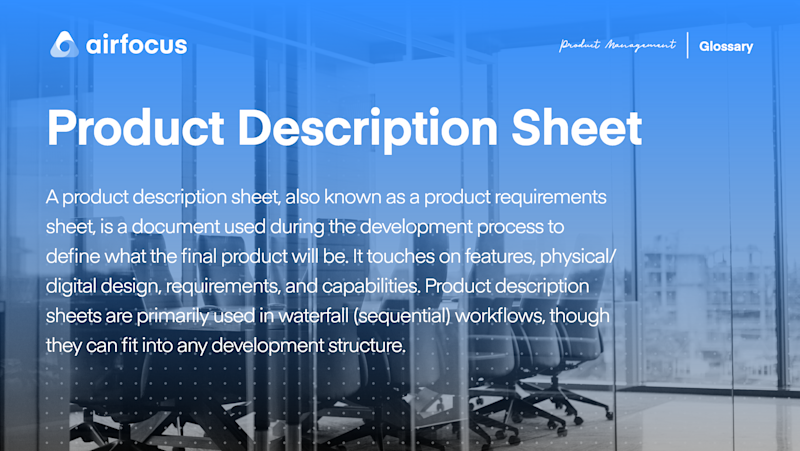Product Description Sheet
What is a Product Description Sheet
Definition of a Product Description Sheet
A product description sheet, also known as a product requirements sheet, is a document used during the development process to define what the final product will be. It touches on features, physical/digital design, requirements, and capabilities. Product description sheets are primarily used in waterfall (sequential) workflows, though they can fit into any development structure.
A product description sheet aims to define the scope and purpose of the product early on. This creates a very different process versus “discovery” development, where a loose concept gradually grows into a fully-formed output.
Product description sheets are useful for translating the ideas and goals of the management team into a vision that the development team can execute on. Without a tool like this, it's easy for management to lay out vague ideas that are difficult for the development team to gauge and translate.
What should a product description sheet contain?
The essential ingredients for a product description sheet are:
Product overview: This should explain the goal in creating the product, answering the question: "Why does this product exist?"
Features: This should cover everything the product will be capable of, separated into categories of "should have" and "could have". If a feature is complex, it could be broken into sub-features for added clarity.
Supported systems and environments: This section will list which systems and settings the product will be available on.
Who creates a product description sheet, and why is it important?
The product description sheet is a key document in the development process. The product manager should create a product description sheet and it should contain crucial information about the project objective, features, UX flow, design notes, requirements, and assumptions.
Because it's the product manager's job to write the product description sheet, it’s easier for them to identify when the product is ready to deliver. However, the product description sheet should be available to everyone. Cross-functional teams can make great use of product description sheets because they can help guide engineering, designing, and marketing efforts.
Product description sheets are helpful for management to translate their ideas and goals into a vision that the development team can work towards. They are a tool that can make it simple to transform vague ideas into workable tasks.
With a well-written product description sheet, you can start prioritization efforts much earlier than teams without a product description sheet. The product description sheet will contain assumptions, constraints, and dependencies. This is crucial in the early stages because it sets limitations for the product and makes it clear to the teams which tasks they should carry out first.
Product description sheet vs. market description sheet
The terms product description and market description sheets are often used interchangeably because they can both offer similar value to the project. However, both documents are unique and are better suited for specific purposes.
Market description sheets outline the issues and needs of the customers you’re building the product for. In contrast, the product description sheet is a formal document that outlines the product’s capabilities, functionality, and features.
The market description sheet explains why you’re building a product, and the product description sheet explains how you will build it.
Tips for creating a product description document
Do your homework
Market research is essential for every project you work on. Just because you can make a product doesn’t mean that you should. You need to be certain that there is a need for your new product and that your competitors don’t have a similar product that’s already better than what you could build.
This research will help build confidence in the product and should be included in the document in some way to help development teams keep the end user in mind throughout the development process.
Ensure usability
Ensuring usability is something development teams can struggle with. They’ll hit the testing stage and are surprised that first-time users struggle with the product. To avoid this roadblock, you should be performing usability testing during requirements development rather than during implementation.
The product manager and designer should attend the testing sessions. It can be difficult for testers to describe issues fully, so you should be paying close attention to what the users do and what they say. You can also invite stakeholders to testing sessions to gain a different perspective.

General FAQ

Glossary categories
Experience the new way of doing product management

Experience the new way of doing product management








